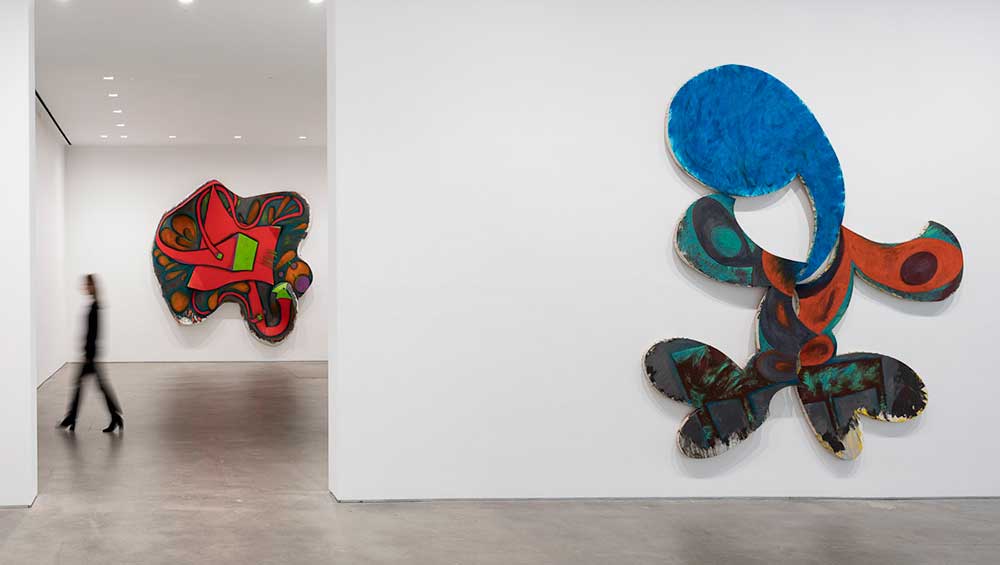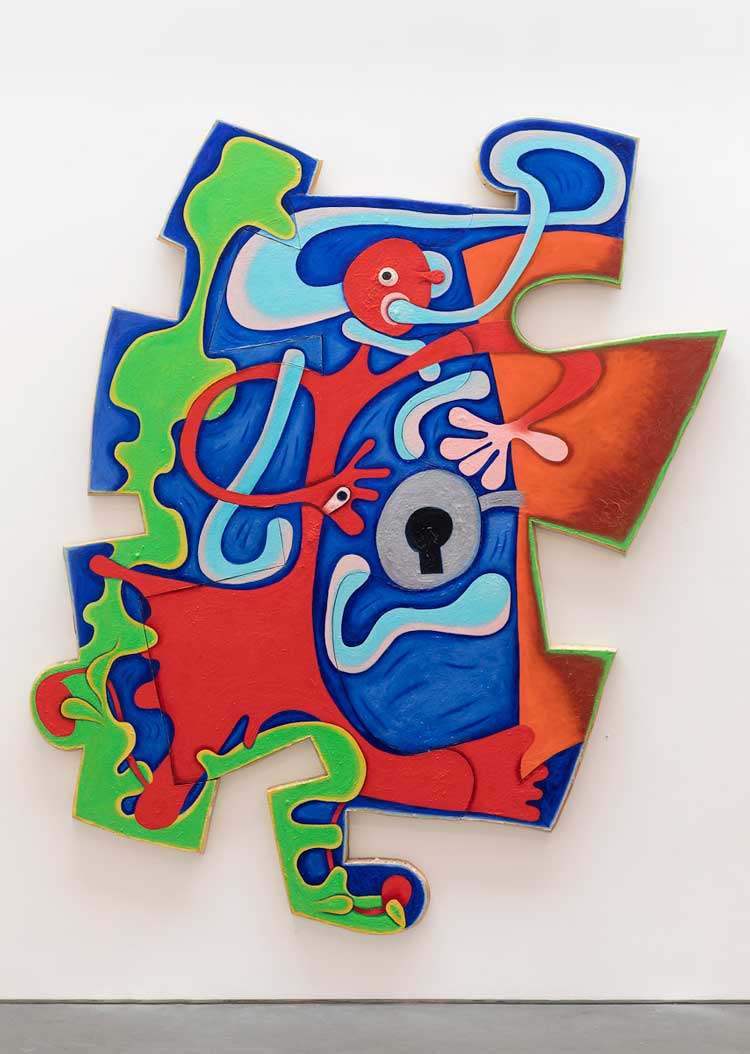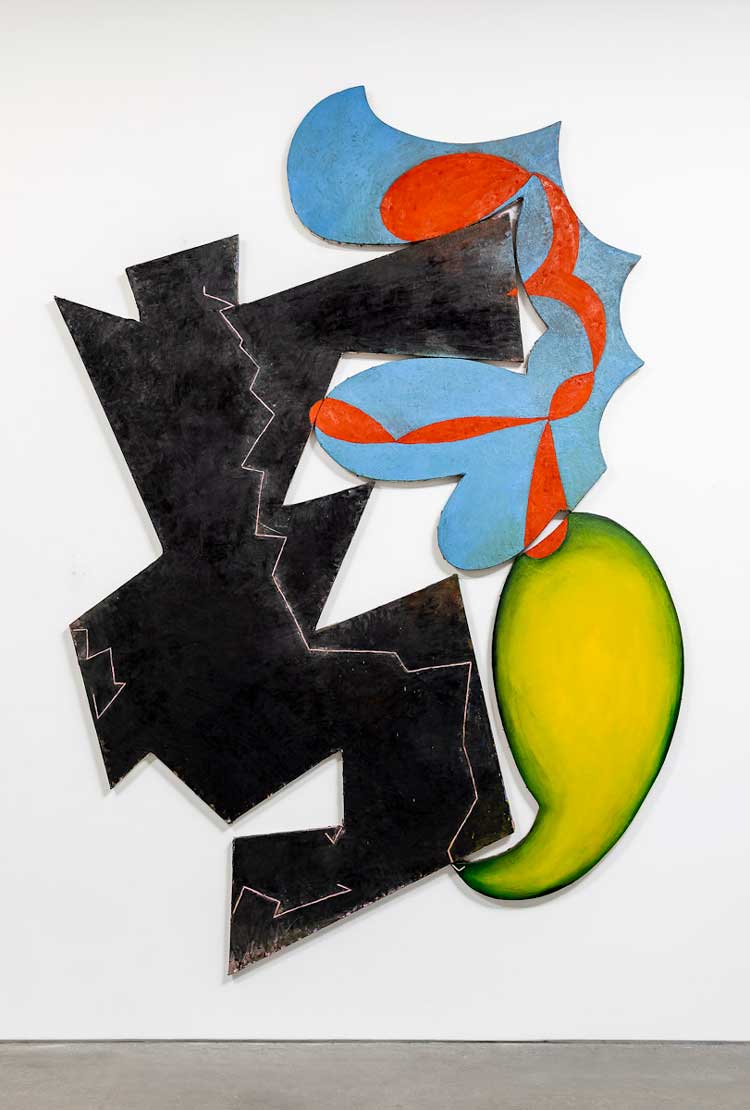
Installation view, Elizabeth Murray, at Gladstone Gallery, 2021. © 2021 The Murray-Holman Family Trust / Artists Rights Society (ARS), New York. Courtesy of The Murray-Holman Family Trust and Gladstone Gallery.
Gladstone Gallery, New York
30 October – 17 December 2021
by LILLY WEI
The five high-stepping, eye-stopping, quirkily configured paintings on view at Barbara Gladstone in New York are by the American painter Elizabeth Murray (1940-2007) in her first solo at the gallery. Four are from the 1980s and one from 1999, all hovering around the nine-foot mark and bigger, holding their own vis-a-vis her male contemporaries. Characterised by a remarkable dynamism and an almost sonic colouration in addition to scale, that kick-ass energy seemed drawn from her own endless vitality which, in turn, was fed by the clash and clatter of the fully lived life that swirled around her: children, husband, friends, fellow artists – no reclusive ivory tower for her. And no theoretical, parochial, patriarchal straitjackets dictated by autocratic (male) critics either. Murray marched to the (up)beat of a more feminist drumming –her utterly confident stride her own.
As the 1980s began, painting returned, after a decade of invisibility, a restoration that Murray helped jumpstart. She was, in short, a success story, one of the few female artists at the time who had name recognition and was consistently exhibited – although their ranks were increasing – and among her many awards were a MacArthur fellowship (1999) and a fully-fledged retrospective at the Museum of Modern Art in New York (2005), two years before her untimely death. But all that was not enough to assure this once eminent artist her place in history and, after that, she went into partial eclipse. Although there were sightings here and there (her longtime former gallery, Pace, showed works of hers from the 80s about four years ago), they were not of the scope befitting an artist of her daring, irreverent originality.

Elizabeth Murray. Back in Town, 1999. Oil on canvas, 97 x 92 in (246.4 x 233.7 cm). © 2021 The Murray-Holman Family Trust / Artists Rights Society (ARS), New York. Courtesy of The Murray-Holman Family Trust and Gladstone Gallery.
One reason for the neglect might be found in what buoyed her in the first place: her valorisation of the domestic, and her disinterest in the theoretical, although she was a fierce advocate for women in the arts and beyond. Having worked her way through surrealism, cubism, abstract expressionism and minimalism, she found her own voice soon enough and proclaimed it with intrepidity and humour, a hero to many women. Yet, although Murray was critically lauded, there was always something a little grudging, a little qualifying in that praise, as if any art that focused on women’s lives and domesticity as its central theme lacked sufficient seriousness. Presumably, we have advanced on numerous fronts in our thinking since then, but there is, obviously, much more to address and ameliorate.
As much relief as painting, they look as fresh as if they had just been made – not something that can be said for all the art of the period – each of the five works have commendably been given an entire wall, for wiggle room. In fact, they shine brighter, burnished by the confirmation of their prescience and singularity. Domesticity is no longer simply brushed aside, downgraded (as men, once sole masters of the uni/metaverse, are pushing prams in record numbers these days as well as deftly changing nappies, etc). And a new diverse generation has taken on further challenges across the board in the name of equity, empowered and underpinned by the mainstreaming of some key tenets of 70s gender battles and other feminist and pluralistic platforms.

Elizabeth Murray. Sentimental Education, 1982. Oil on canvas, 127 x 96 in (322.6 x 243.8 cm). © 2021 The Murray-Holman Family Trust / Artists Rights Society (ARS), New York. Courtesy of The Murray-Holman Family Trust and Gladstone Gallery.
Murray’s paintings have always been assertive, expansive, like her strongly held system of values and allegiances. An exuberant but controlled balance of deft pictorial feints, much of their impact, besides eccentrically shaped canvases, is due to her distinctive choice of colours: bright, brash, tender, interspersed with astringent, darker notes. The imagery is primarily geometric in this body of work, innovatively so, as Murray improvised her own biomorphic vocabulary, one that will later swing into outright, cartoon-like representation (her hallmark coffee cups – decidedly not teacups, tables, rumpled beds, overturned chairs, (mislaid?) keys, sneakers and other intimate, utilitarian objects of daily use, re-examined, revalued), combining the two modes with verve, swagger and wayward charm. The painted images here tilt towards the abstract, sharp-edged, rounded, the restive surfaces satisfyingly thick with scumbled, dripped, splattered and smeared paint. Despite their size, her constructs, whether rectilinear or more eccentric in format, are never crushing, her measurements only magnifying and highlighting what matters to her. Two from 1982, Flying Bye and Water Girl (the latter seems about to exultantly fling itself off the wall), are built from the irregularly formulated multiple panels that she started to use in the early 80 in which the incorporation of the supporting wall becomes increasingly integrated into the composition, merging external and artistic reality, negative and positive space. More figurative is the accommodatingly elastic Gumby-like figure that is the lead actor of the latest painting here, which is how we all must feel like at times – stretched, bent out of shape, but perhaps also triumphant, able to catch what’s thrown at us. From 1999, it is shaped like a gigantic puzzle piece, its crenellated contours ready to be fitted into other pieces, if not always smoothly, fragments that come together, fall apart and regroup, constituting a life. Its title is apt: Back in Town. Indeed, she is, and welcome.
• Murray has also been the subject of two recent major museum exhibitions, Wild Life: Elizabeth Murray and Jessi Reaves, organised by the Contemporary Arts Museum Houston and curated by Rebecca Matalon, which is at the Carnegie Museum of Art until 9 January 2022, and Elizabeth Murray: Back in Town, curated by Robert Scalise, which was at the University at Buffalo Art Galleries earlier this year.